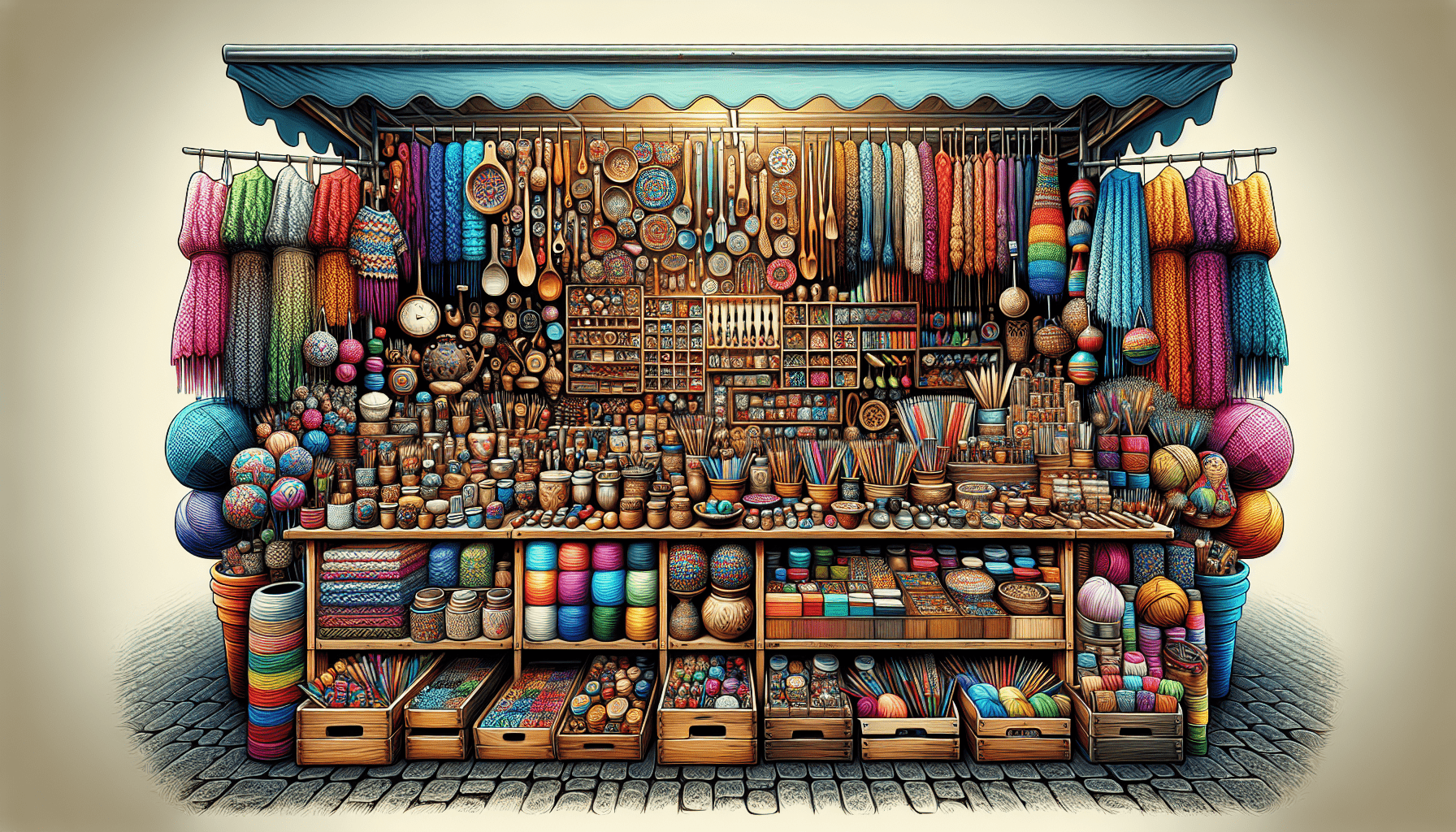Have you ever wondered what sets a bazaar apart from a craft show? Perhaps you’ve found yourself contemplating the similarities and differences between these two popular events. Well, rest assured, because today we’re going to explore the distinctions between a bazaar and a craft show. So, sit back, relax, and let’s embark on this delightful journey of discovery together.
Definition of Bazaar
A bazaar is a marketplace or a street market where goods are sold, typically by individual vendors. It is a vibrant and bustling event where you can find a wide array of products, ranging from handicrafts, clothing, jewelry, accessories, home decor, food items, and more. The term “bazaar” originated from the Persian word “bāzār,” meaning “a place of prices.”
Origin of the Term
The concept of bazaars can be traced back to ancient times, dating back to the Middle East and the Mediterranean region. Bazaars played a vital role in trade and commerce during the Silk Road era, serving as a meeting point for merchants from different countries to exchange goods. Today, the term “bazaar” is used globally to describe these vibrant marketplaces that offer a unique shopping experience.
Meaning and Concept
The essence of a bazaar lies in its eclectic mix of products, vibrant atmosphere, and the interaction between vendors and shoppers. It is a place where you can immerse yourself in the local culture, discover unique items, and support local artisans and entrepreneurs. Bazaars often embrace diversity, offering an opportunity for various vendors to showcase their products and talents. The concept of a bazaar is centered around creating a lively and engaging environment for both vendors and shoppers.
Definition of Craft Show
A craft show, on the other hand, is an event that focuses primarily on showcasing and selling handmade or artistic products. Unlike bazaars, craft shows are usually organized indoors, such as in exhibition halls, event centers, or community centers. Craft shows provide a platform for artisans to display their craftsmanship and creativity, attracting individuals who appreciate unique handmade items.
Purpose and Format
Craft shows are typically organized with the goal of promoting and supporting the local arts and crafts community. They allow artisans to showcase their skills, creativity, and dedication to their craft. Craft shows often have a specific theme or focus, such as pottery, woodworking, textiles, or jewelry. The format of a craft show usually involves individual booths or tables where artisans can display and sell their products directly to customers.
Bazaar Organizers
Bazaars are organized by a variety of entities, including local community organizations, schools, religious institutions, or entrepreneurial groups. The objective of the organizers is to create a bustling marketplace where vendors can sell their goods and shoppers can find a diverse range of products in one place. Bazaar organizers often collaborate with local artisans, businesses, and vendors to curate a unique and engaging shopping experience for visitors.
Craft Show Organizers
Craft shows are typically organized by specialized event management companies, arts and crafts associations, or community centers dedicated to supporting local artisans. These organizers focus on creating a platform where artisans can showcase their talents and products to a specific target audience. Craft show organizers often invest time and effort into carefully selecting artisans and ensuring a cohesive theme, resulting in a curated and high-quality event.
Bazaar Participants
Bazaars attract a wide range of participants, including local artisans, small businesses, independent vendors, and even hobbyists. It is a welcoming environment that allows individuals to showcase their products and entrepreneurial spirit. Bazaar participants often come from diverse backgrounds, offering an extensive variety of products and unique experiences for shoppers. It is a platform where new entrepreneurs can gain exposure and establish their presence in the market.
Craft Show Participants
Craft shows primarily feature artisans who specialize in handmade products. These participants are dedicated craftsmen and craftswomen who pour their heart and soul into creating unique pieces of art. Craft show participants often have a higher level of skill and craftsmanship, and their products reflect their expertise and creativity. The participants at craft shows are carefully selected to maintain a certain standard of quality and artistic value.
Variety of Products
Bazaars are known for their diverse range of products. You can find anything from handmade clothing, accessories, home decor, traditional crafts, artwork, antiques, food items, and more. The vast array of products ensures that there is something for everyone at a bazaar.
Artisans at Bazaars Artisans at bazaars often create products that cater to a wider audience. They may produce items in larger quantities to meet the demands of the market. Buyers at bazaars are often looking for affordable and unique items that can be used in their daily lives or given as gifts.
Artisans at Craft Shows Craft shows showcase the skill, artistry, and creativity of artisans who produce handmade goods. These artisans focus on creating one-of-a-kind pieces that are considered works of art. The products displayed at craft shows are often unique, intricately crafted, and may be priced higher due to the time and effort invested in their creation.
Typical Bazaar Setting
Bazaars are usually held in open-air spaces such as public squares, streets, or outdoor marketplaces. The atmosphere is vibrant and bustling, with vendors setting up colorful stalls or canopies to display their products. The sights, sounds, and aromas of a bazaar create an immersive experience that engages all of your senses. Bazaars often have a festive vibe, especially during cultural or religious celebrations, attracting locals and tourists alike.
Typical Craft Show Setting
Craft shows are typically held indoors, providing a controlled environment for artisans to showcase their products. The event venue may be an exhibition hall, community center, or other indoor spaces with designated booths or tables for each artisan. Craft shows prioritize a well-organized layout that allows visitors to explore the artisans’ offerings and interact with them one-on-one. The indoor setting provides protection from weather conditions and allows for a more curated presentation of unique handmade items.
Atmosphere Differences
The atmosphere at a bazaar is lively, energetic, and dynamic. You are likely to encounter enthusiastic vendors calling out to attract your attention, bustling crowds, and vibrant colors all around. The outdoor setting and the interactions with vendors and shoppers create a sense of community and excitement. In contrast, a craft show has a more controlled and calmer atmosphere. The focus is on appreciating the craftsmanship and discussing the intricacies of the products with artisans. Visitors often have the opportunity to gain insight into the creative process and learn more about the artisans’ inspiration behind their work.
Commercial Aspect of Bazaars
While bazaars provide a platform for artisans and small businesses to sell their products, they also have a significant commercial aspect. Vendors at bazaars often aim to attract as many customers as possible to maximize their sales. They may offer discounts, promotions, or bundle deals to entice shoppers. Bazaars can also serve as an opportunity for larger businesses or retailers to showcase their products and reach a broader customer base.
Creative Aspect of Craft Shows
Craft shows are primarily driven by the creativity and artistic expression of artisans. While the goal is to sell their products, craft show participants often prioritize sharing the story behind their creations and connecting with customers on a personal level. Visitors to craft shows have the chance to appreciate the skill and craftsmanship that goes into each piece and develop a deeper understanding of the art form. The creative aspect of craft shows elevates the experience beyond a mere shopping trip.
Pricing at Bazaars
Bazaars are known for offering affordable options for shoppers. The pricing at bazaars varies depending on factors such as the uniqueness of the product, the materials used, and the bargaining culture of the region. It is common for vendors at bazaars to set slightly higher initial prices, leaving room for negotiation or bargaining. This haggling aspect adds to the lively atmosphere and gives shoppers an opportunity to secure a good deal.
Pricing at Craft Shows
Craft shows often feature higher-end, unique, and artistically crafted products. The pricing at craft shows reflects the time, effort, and skill invested by artisans in creating their pieces. While some items may be more expensive compared to those found at bazaars, visitors to craft shows are often more willing to invest in the quality, artistry, and exclusivity of the products they find.
Bartering Traditions
Bazaars are known for their bartering traditions, where vendors and shoppers engage in friendly negotiations to agree on a price. Bartering adds a sense of excitement and personal interaction to the shopping experience. It allows both parties to feel a sense of accomplishment in obtaining a fair deal. The art of bartering at bazaars can be seen as a cultural practice and a way to connect with the local traditions.
Activities at Bazaars
Bazaars often offer a wide range of activities to engage shoppers and create an enjoyable experience beyond shopping alone. These activities may include live performances, music, dance, cultural demonstrations, workshops, food tasting, or games. Bazaars are not just about shopping; they aim to create a festive and entertaining atmosphere for everyone to enjoy.
Entertainment at Craft Shows
Craft shows focus more on the presentation and appreciation of artistic craftsmanship. While craft shows may not encompass as many activities as bazaars, they often highlight the artistic process through live demonstrations or workshops. Visitors have the opportunity to observe artisans at work, gaining insight into their techniques and creative journey. The entertainment aspect of craft shows lies in witnessing the skill and talent of the participating artisans.
Promotion of Bazaars
Bazaar organizers typically use various promotional strategies to attract visitors. These can include social media campaigns, traditional advertising methods such as flyers and posters, word-of-mouth marketing, partnerships with local businesses, or collaborations with local media outlets. The goal is to create awareness and generate excitement for the upcoming bazaar, enticing potential customers to attend.
Advertising for Craft Shows
Craft show organizers often employ a targeted advertising approach, focusing on reaching individuals interested in handmade goods and artisanal products. They may advertise through craft-related publications, digital platforms, artisan networks, or collaborations with art galleries or studios. Craft show advertisements highlight the unique artistic offerings, the caliber of participating artisans, and the overall experience visitors can expect.
Occurrence of Bazaars
Bazaars can occur throughout the year, depending on local traditions and events. Some bazaars are regular weekly or monthly markets, while others may coincide with specific holidays, festivals, or special occasions. Bazaars are deeply rooted in communities and often hold sentimental value, becoming eagerly anticipated annual traditions for both locals and tourists.
Scheduling Craft Shows
Craft shows are typically scheduled as individual events that occur less frequently compared to bazaars. Craft show organizers take into consideration various factors such as the availability of artisans, the demand for handmade products, and the local arts and crafts scene when planning the scheduling. Craft shows may be held annually, bi-annually, or on a specific seasonal basis to provide a distinct and curated experience for visitors.
In conclusion, both bazaars and craft shows offer unique shopping experiences that appeal to different tastes and preferences. Bazaars embody a lively and bustling marketplace, where you can find a variety of products at affordable prices. Craft shows, on the other hand, focus on showcasing the artistic craftsmanship and creativity of skilled artisans. Whether you’re looking for a vibrant cultural experience or seeking a one-of-a-kind handmade item, both bazaars and craft shows provide an opportunity to discover and support local talent while immersing yourself in the world of arts and crafts.



